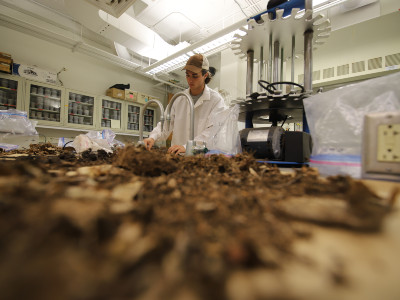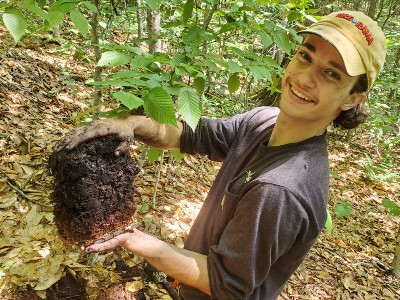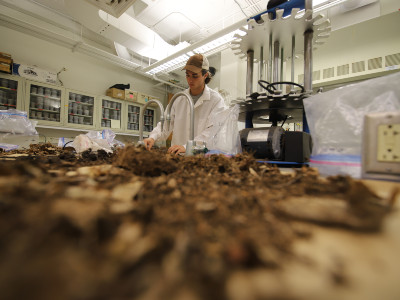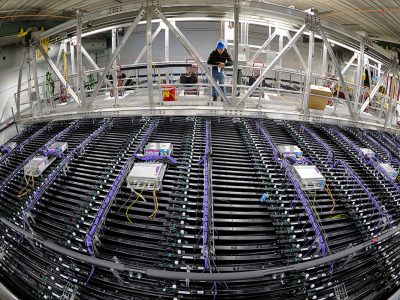Whether he’s exploring rocky quarries, mountain biking on winding trails or training for club gymnastics, Trygve Moler prefers the outdoors. Growing up in Montana, he spent his childhood playing in open fields and poking around the wilds, instilling in him a deep appreciation for nature.
“My family camped a lot when I was younger,” he says. “I grew up living on the edges of town with fields and ditches to explore. Even as I’ve gotten older, I’ll take any excuse to be outside.”
Moler’s strong connection to the outdoors also made him aware of the current climate crisis that’s affecting Montana. Soaring temperatures, blazing wildfires and winters that rival Syracuse’s chilly seasons have wreaked havoc on his home state.
“It’s not hard to notice highly irregular snowfall, extreme forest fires and smoke when I’m living through them. Right now, Montana is experiencing a serious heat wave,” he says. “Winter is also unpredictable. Sometimes we barely get snow, but other times we get more than expected.”

These experiences ultimately shaped Moler’s decision to pursue environmental engineering at Syracuse University. He has just started his sophomore year. “There really was never a question about it,” he says. “I knew I wanted to be an engineer and when I saw environmental was an option. It was an immediate choice.”
Through an internship with Chris Johnson, professor of civil and environmental engineering, Moler gained experience in environmental lab and field work while considering possible career paths. Alongside fellow interns in Johnson’s biogeochemistry laboratory, he spent his summer in New Hampshire and in Link Hall analyzing phosphorus in soil samples.
Phosphate, a naturally occurring form of the element phosphorus, plays a crucial role in plant growth and development, providing the essential nutrients required for root growth, seed formation and winter survival. When there’s a sufficient amount of phosphate in the soil, plants can grow to be healthier and stronger. But when there isn’t enough phosphorus, plant growth can be slow.
The soil samples were collected from the Hubbard Brook Experimental Forest in the White Mountains of New Hampshire. For decades, scientists have conducted research in the area to better understand the environment and forest ecosystems.

“For the purposes of my group, Hubbard Brook has the perfect climate to slow the decomposition of organic matter in the soil to a matter of years rather than months, which allows us to study how phosphorus and many other important nutrients cycle through the soil,” Moler says.
Moler’s trip to Hubbard Brook was an amazing opportunity for fieldwork. He and the team stayed in a cabin and journeyed through the wilderness on days it wasn’t raining.
In certain locations, markers on the ground and on the map indicated the areas to collect soil samples from. The soil was dug from the ground, placed into individual bags, and the size and volume of the sample was recorded. On a typical day, each group would collect samples at between eight and 15 sites.
Moler and his group returned the samples to the lab for analysis. He and another intern took turns preparing the samples to extract various forms of soil phosphorus. The process involved weighing soil samples, mixing acids and bases, shaking them to promote the extraction and centrifugation to separate the solids from the liquid. The extract solutions were then analyzed for phosphate and total phosphorus.
“I really enjoy my research,” Moler says. “My coworkers and the lab space are great, and I think this experience will be invaluable in the coming years. This is the most involved work I’ve ever been a part of.”
While interning at the biogeochemistry laboratory, Moler was introduced to a field he never knew existed and soon discovered the vastness of environmental research. Something as seemingly simple as soil had extensive research and analysis. Even nutrients found within the soil like nitrogen also had entire papers and in-depth studies, which he found fascinating.
“All the chemistry I’m learning is new. I didn’t even know biogeochemistry crossed over,” Moler said. “That entire area was unknown to me, and I was shocked about how deep every component of it was, including all the elements in the soil. You can read so much about it and all the experiments people have conducted. It was interesting to discover.”
When Moler isn’t working on analysis, he’s somewhere in the wilderness or participating in physical activities. He’s expressed interest in joining the University’s Outing Club.
However, his adventurous spirit goes beyond internships and extracurricular activities. He intends to study abroad in Santiago, Chile, which will allow him to immerse himself in a new culture, explore unfamiliar places and practice his Spanish.
“Chile was an easy choice for me. In my fourth year of Spanish, I reported on the culture, history, environment and current affairs of Chile, so I’m already fairly invested in the country,” he says. “I think it’ll be a cool place to study and explore. I’ve also been studying Spanish for four years, so I would love to make the leap to complete fluency.”
Moler considers these experiences to be vital and encourages Syracuse students to seize every opportunity to enhance their college experience through internships, extracurricular activities and study abroad programs. Such experiences have helped him gain clarity about his future goals and career aspirations.
“For jobs and internships, just get moving,” he says. “I struggled for my first semester to find any opportunities, but it just takes some time and continuous applied effort. Talk to your professors, send emails, ask questions, check on different options, apply regardless of the requirements and things will happen, especially here in Syracuse.”
“On the other hand, never take yourself too seriously,” he adds. “It’s easy to get wrapped up in these big leaps and bounds that college allows us to make. But always remember to take time to have fun and play like a kid.”



